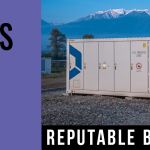 A key advisory panel to the Department of Energy wants to move ahead on a biennial assessment required by law of how the agency is doing in its support of the U.S. energy storage technology.
A key advisory panel to the Department of Energy wants to move ahead on a biennial assessment required by law of how the agency is doing in its support of the U.S. energy storage technology.
But the committee is waiting to hear back from DOE on its response to recommendations in its last report from 2016 before it can move ahead in earnest, said Ramteen Sioshansi, a professor at Ohio State University and the chairman of the Energy Storage Subcommittee of DOE’s Electricity Advisory Committee (EAC).
“My strong preference would be to have a response to the ’16 assessment before doing the ’18 assessment,” Sioshansi said. While waiting, his panel will “do a little bit of preliminary ground work on the ’18 assessment,” he said.
The storage subcommittee submitted its 2016 assessment in September of that year. The report made recommendations in 15 areas, ranging from program goals, demonstration projects and funding to the economics of energy storage and its interplay with current electricity market designs.
Typically, DOE has responded to such reports from the EAC or its subcommittees in a matter of months, accepting or rejecting recommendations.
“There was a lengthy transition period so I can understand some things may be taking a little longer to get out of the department, so that’s understandable from my perspective,” said Sioshansi. “I understand there are a bunch of eyes looking at [the response],” he added. “They want to put out a response that they’re happy with.”
The biennial assessment on energy storage is required by the Energy Independence and Security Act of 2007. It is supposed to evaluate how DOE is meeting the goals of a five-year plan to support energy storage industry efforts in electric drive vehicles, electricity transmission, and distribution and stationary applications.
At the meeting of the EAC in Arlington, Va., last week, during a segment on regulatory reforms, members of the committee were presented with a list of options, among which were doing away with the five-year plan and the assessments every two years.
read more
 Researchers at Korea’s Advanced Institute of Science and Technology (KAIST) have developed a new type of aqueous energy storage device that they claim can be charged in less than half a minute.
Researchers at Korea’s Advanced Institute of Science and Technology (KAIST) have developed a new type of aqueous energy storage device that they claim can be charged in less than half a minute. Electric cars could soon have as much range as petrol and diesel cars — and recharge in a matter of minutes — thanks to what researchers are calling a “breakthrough” in energy storage technology. Teams from Bristol University and Surrey University have created a new material for supercapacitors, which store electric charge, that could see EVs
Electric cars could soon have as much range as petrol and diesel cars — and recharge in a matter of minutes — thanks to what researchers are calling a “breakthrough” in energy storage technology. Teams from Bristol University and Surrey University have created a new material for supercapacitors, which store electric charge, that could see EVs  New York’s vision for cleaner a more distributed utility grid will rely heavily on energy storage, and last week regulators took two steps to help grow the resource.
New York’s vision for cleaner a more distributed utility grid will rely heavily on energy storage, and last week regulators took two steps to help grow the resource. Researchers have claimed a breakthrough in energy storage technology that could enable electric cars to be driven as far as petrol and diesel vehicles, and recharge in minutes rather than hours.
Researchers have claimed a breakthrough in energy storage technology that could enable electric cars to be driven as far as petrol and diesel vehicles, and recharge in minutes rather than hours. LONDON
LONDON If New Jersey is going to achieve the Murphy administration’s ambitious clean-energy goals, storing the energy created by renewable power sources such as solar and wind will be crucial.
If New Jersey is going to achieve the Murphy administration’s ambitious clean-energy goals, storing the energy created by renewable power sources such as solar and wind will be crucial. If storage is the Swiss army knife of the electric grid, then U.S. energy regulators are breaking out their tool belts.
If storage is the Swiss army knife of the electric grid, then U.S. energy regulators are breaking out their tool belts. The
The 



